A Sense of Doubt blog post #2027 - It's Time for a More Perfect Union - Hodge Podge Weekly for 2009.05
Despite saying I was "taking a break," the WEEKLY HODGE PODGE is popular and this one has tons of good stuff from FAKE NEWS to Dinosaur deniers to a Joni Mitchel biography to more GOP nonsense and hateful shit nation wide.
Same as it ever was.
Theme for this week is taken from Obama's famous speech from 2008, "A More Perfect Union," and a line from a song by the late great (RIP) Nipsey Hussle.
AND HEY!! Sections!!!
I organized the content for once into BLACK LIVES MATTER AND RELATED MATERIAL, The Pandemic, and the Election, and RANDOM.
Do I need to curate this content for you? Doesn't it speak for itself?
LET'S GET AFTER IT!!
"Like [Nipsey] Hussle said, never let a hard time humble us," Harden, referring to the late rapper, said.
https://www.espn.com/nba/story/_/id/29799293/rockets-james-harden-makes-series-saving-stop-night-hit-shot



MORE PERFECT UNION SPEECH TRANSCRIPT
/cdn.vox-cdn.com/uploads/chorus_asset/file/18070774/web_59e13b9f0afa4.jpg)
FREE MINDS
Doubts about democracy. A new Pew Research Center poll of Americans finds that "among the public overall, 68% say it is very important for the country that people are free to peacefully protest, down from 74% two years ago. In this case, the decline has come entirely among Republicans," Pew notes.
The poll was conducted from July 27 through August 2 and consisted of 11,001 U.S. adults.
A majority of those surveyed (62 percent) agreed "that significant changes are needed in the fundamental design and structure of American government to make it work for current times." Pew points out that "while views among the public overall have changed little since 2018, Democrats and Republicans have moved further apart in their opinions. Currently, 79% of Democrats say significant changes in the structure of government are needed, compared with 41% of Republicans.
BLACK LIVES MATTER, PROTESTS, RIOTS, AND POLICE KILLING PEOPLE
Prosecutors say you can clearly hear #Rittenhouse call someone on the phone and say, "I just killed somebody," after shooting and killing one man. Minutes later, still armed and now in a different location-- not by police just down the street-- prosecutors say he shot two others. https://t.co/Y25sazZdtz— Jason Fechner (@jasonfechner) September 1, 2020
https://tech.slashdot.org/story/20/08/30/0541228/facebook-ignored-455-complaints-about-militia-page-urging-weapons-at-kenosha-protest
Facebook Ignored 455 Complaints About Militia Page Urging Weapons at Kenosha Protest (buzzfeednews.com)
BuzzFeed News reports:In a companywide meeting on Thursday, Facebook CEO Mark Zuckerberg said that a militia page advocating for followers to bring weapons to an upcoming protest in Kenosha, Wisconsin, remained on the platform because of "an operational mistake." The page and an associated event inspired widespread criticism of the company after a 17-year-old suspect allegedly shot and killed two protesters Tuesday night.
The event associated with the Kenosha Guard page, however, was flagged to Facebook at least 455 times after its creation, according to an internal report viewed by BuzzFeed News, and had been cleared by four moderators, all of whom deemed it "non-violating." The page and event were eventually removed from the platform on Wednesday — several hours after the shooting.
"To put that number into perspective, it made up 66% of all event reports that day," one Facebook worker wrote in the internal "Violence and Incitement Working Group" to illustrate the number of complaints the company had received about the event... The internal report seen by BuzzFeed News reveals the extent to which concerned Facebook users went to warn the company of a group calling for public violence, and how the company failed to act.
After BuzzFeed news published its story about Facebook's internal report, Mark Zuckerberg made the same comments in a public forum, reports CNN:The page clearly violated Facebook's rules against violent militias, Zuckerberg acknowledged in a video posted Friday to his Facebook profile, and that "a bunch of people" had even reported the page prior to the killing of two protesters, Joseph Rosenbaum and Anthony Huber.
Just last week, Facebook announced it would crack down on militia organizations that advocated for violence or spoke about the potential for violence. But in its first week of implementation, the policy's lack of enforcement led to the spread of violent messages on the platform directly linked to the events in Kenosha, where protests erupted after the police shooting of Jacob Blake.
The event associated with the Kenosha Guard page, however, was flagged to Facebook at least 455 times after its creation, according to an internal report viewed by BuzzFeed News, and had been cleared by four moderators, all of whom deemed it "non-violating." The page and event were eventually removed from the platform on Wednesday — several hours after the shooting.
"To put that number into perspective, it made up 66% of all event reports that day," one Facebook worker wrote in the internal "Violence and Incitement Working Group" to illustrate the number of complaints the company had received about the event... The internal report seen by BuzzFeed News reveals the extent to which concerned Facebook users went to warn the company of a group calling for public violence, and how the company failed to act.
After BuzzFeed news published its story about Facebook's internal report, Mark Zuckerberg made the same comments in a public forum, reports CNN:The page clearly violated Facebook's rules against violent militias, Zuckerberg acknowledged in a video posted Friday to his Facebook profile, and that "a bunch of people" had even reported the page prior to the killing of two protesters, Joseph Rosenbaum and Anthony Huber.
Just last week, Facebook announced it would crack down on militia organizations that advocated for violence or spoke about the potential for violence. But in its first week of implementation, the policy's lack of enforcement led to the spread of violent messages on the platform directly linked to the events in Kenosha, where protests erupted after the police shooting of Jacob Blake.
Mississippi's Attorney General drops murder charges against Curtis Flowers after he spent over 23 years in prison
Curtis Flowers is now a free man after Mississippi's AG decided to drop all charges related to a quadruple homicide. Flowers had spent nearly 23 years in prison and had been tried six times for the same crime. He always maintained his innocence, and the charges were dropped on Friday after the prosecutor was found to have excluded Black jurors. Flowers gained recent fame in large part due to a popular podcast series that highlighted his case.
Photo via @TheRootMurder charges against Curtis Flowers have been dropped. He has already been tried six times for the same killings.— AJ+ (@ajplus) September 4, 2020
In 2019, the Black man was released from prison after SCOTUS tossed his murder conviction, ruling the white prosecutor kept Black people from serving on the jury. pic.twitter.com/lbXSpdBAPH
BREAKING NEWS: The Mississippi Attorney General has just dropped the case against Curtis Flowers. After six trials and 23 years, the case against Curtis Flowers is finally over. We’ll have a special episode of @InTheDarkAPM out later today. #CurtisFlowers https://t.co/g3oAHS2gQt— Madeleine Baran (@madeleinebaran) September 4, 2020
https://www.wonkette.com/

We're not big on primarying Democrats usually, but this is correct. Richie Neal, who stopped legislation to ban surprise billing (where you go to a hospital in network, and they give you a doctor who takes no insurance), has to go. Oh wait, the election was yestertoday, well maybe we know by now if you did it! — Jordan Weissmann at Slate
Former Los Angeles sheriff's deputy, now in hiding, testifies: "There are parties after shootings. They call them '998 parties.' Some people say it's to celebrate the deputy is alive. Others say it's to celebrate that they're going to be 'inking' somebody." (Spectrum News 1)
Mmmm, good questions?
Deep breath. Former Milwaukee sheriff David Clark tells listeners how to shoot a protester and get away with it. — Media Matters
And deep breath again: "Patriot Prayer has been linked to murders and other violent attacks. The New York Times described it as promoting 'Christianity and smaller government.'" (Media Matters)
Wow.
Daniel Prude died March 30, seven days after Rochester, New York police put a hood over his head and pressed his face into the pavement for two minutes.— Mike Sisak (@mikesisak) September 3, 2020
The world only found out about it today, when his family released video and records of the incident.https://t.co/DwNi7Ki3Wz
NEWS: In March, Joe Prude called the police for help. His brother, Daniel, was acting strangely. Instead, video shows Rochester police handcuffing him, mocking him, and kneeling on his back while pushing his face into the ground until he stops breathing. https://t.co/VHerJ27Di7— The Appeal (@theappeal) September 2, 2020
I watched the video.— Marcel Louis-Jacques (@Marcel_LJ) September 2, 2020
Daniel Prude Is naked in the street, in the snow, clearly having a mental break down. He immediately complies with officers and is laying face down on the asphalt, handcuffed, as officers put a spit sack over his head and press his face into the ground https://t.co/mWWgzzvGHH
This is Joe Prude, the brother of Daniel Prude. He says he called 911 for help with his brother. @news10nbc “I called for my brother to get help.” pic.twitter.com/PgjqaDh71b— Berkeley Brean (@whec_bbrean) September 2, 2020

https://www.wonkette.com/suspect-in-portland-shooting-shot-and-killed-by-the-officers-sent-to-arrest-him
https://www.wonkette.com/joe-biden-just-ended-donald-trumps-campaign
President Donald Trump alleged unnamed people in “dark shadows” are controlling Democratic nominee Joe Biden https://t.co/2Yb3eSpNns— POLITICO (@politico) September 1, 2020

https://www.thedailybeast.com/trump-says-the-kenosha-cop-who-shot-jacob-blake-just-choked-like-a-golfer-missing-a-putt
Trump: Cop Who Shot Jacob Blake Just ‘Choked’ Like a Golfer Missing a Putt
DISGUSTING
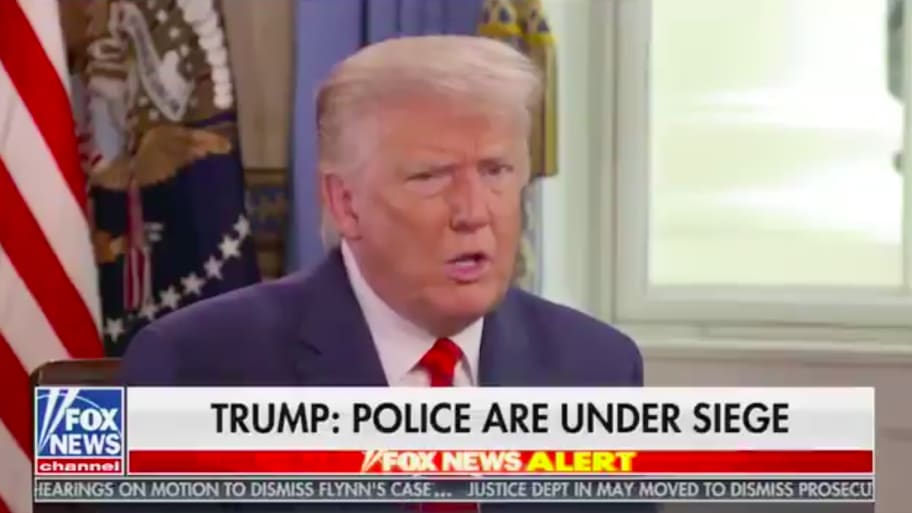
Read it at The Hill
President Donald Trump has said the police officer who shot Jacob Blake in the back seven times last month was just having a bad day, like a golfer who misses a simple putt. The president’s astonishing analogy came in an interview with Laura Ingraham on Fox News, who, apparently realizing how offensive Trump’s stream of consciousness was, stepped in to stop him from finishing it. “Shooting the guy in the back many times, I mean, couldn’t you have done something different? Couldn’t you have wrestled him?” Trump said of the Kenosha, Wisconsin, incident. “But they choke. Just like in a golf tournament. They miss a three-foot putt.” Ingraham interjected: “You’re not comparing it to golf, because that’s what the media will say.” Trump responded: “I’m saying people choke... People choke.” Trump is due to visit Kenosha, where Blake’s shooting took place, later on Tuesday—despite city and state officials urging him to stay away. Kenosha Mayor John Antaramian said Monday the timing of the president’s visit “is not good.”
https://www.opb.org/article/2020/09/03/injured-protest-medic-had-to-wait-for-medical-treatment-after-being-tackled-punched-by-portland-police/Trump compares killing an unarmed black civilian to missing a three foot putt in a golf tournament, Ingraham jumps in to make him stop. pic.twitter.com/NeHqVn4Uvf— Josh Marshall (@joshtpm) September 1, 2020
Injured protest medic waited for medical treatment after being tackled, punched by Portland police
Person punched repeatedly by police at Portland protest was taken to OHSU, where he works as an ICU nurse, for a head injury
In an incident filmed late Monday, a Portland police officer is seen tackling and repeatedly punching a volunteer medic named Tyler Cox.
Cox was arrested on a charge of assaulting a police officer and taken away in a riot van, despite having what he described Wednesday as significant injuries.
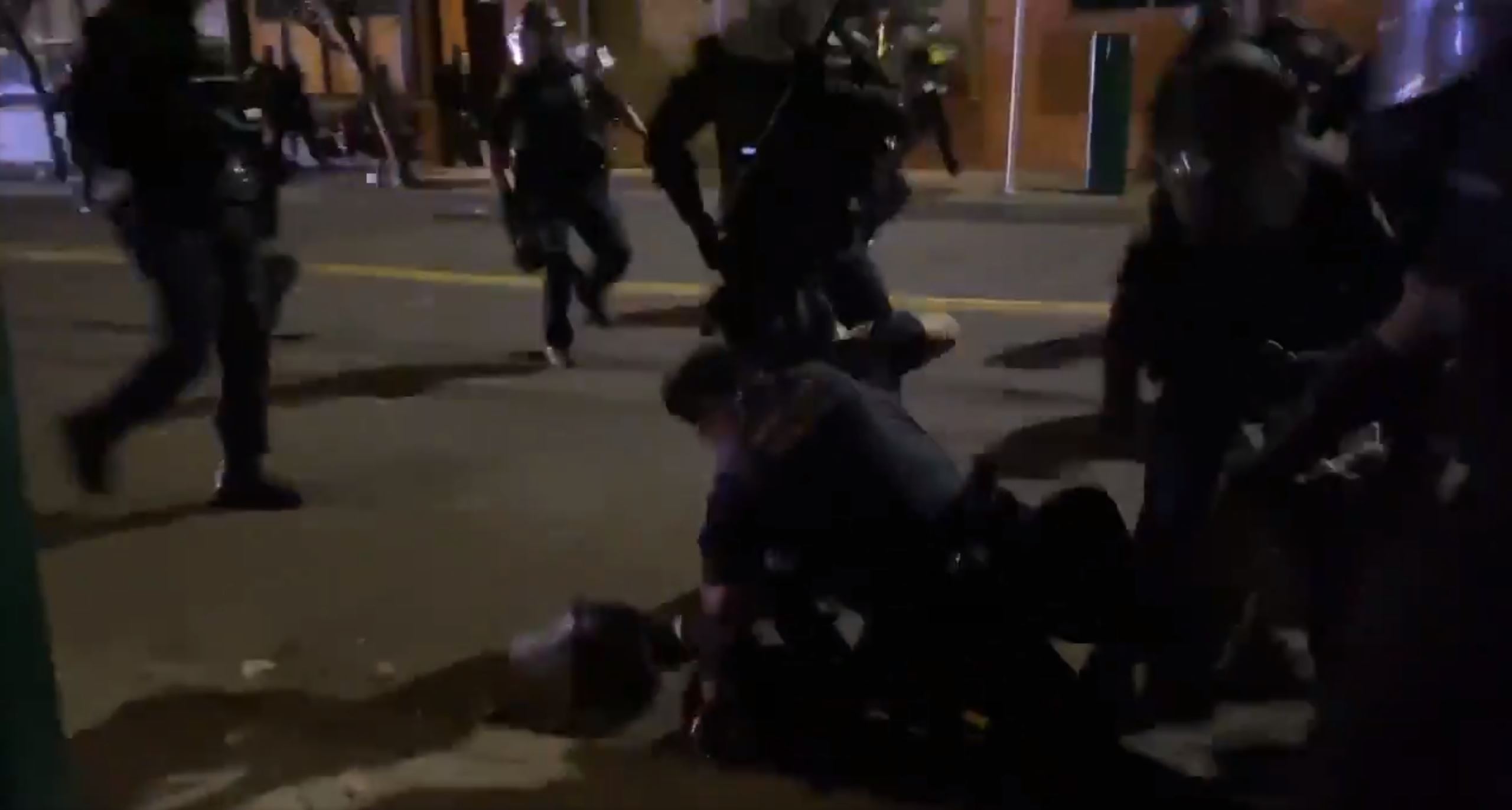
A Portland police officer punches a protester after throwing them to the ground while dispersing a demonstration Monday, Aug. 31, 2020, in Portland, Ore. The incident is under investigation.
Sergio Olmos / OPB
Cox says he went more than two hours without medical attention before paramedics evaluated him.
“They noted that I was lethargic. And they noted that I was having trouble walking straight. They told the police officers that they couldn’t clear me to be arrested, or to be taken to jail without a head CT, or taken to the hospital at the least,” Cox said Wednesday. “The police actually got angry with them about that.”
Police ended up taking Cox to the emergency room at OHSU, the same place he works as an intensive care unit nurse.
He said he was appalled by the way police and the hospital treated his injuries. He said police and hospital officials downplayed the severity at first and Cox suspects it was because he was at a protest.
“They just kind of were treating me like they didn’t respect people who were the part of the protest,” he said. “They were dismissive. They didn’t ask me if I needed anything. I was never offered water [or] offered anything for pain.”
more at
https://www.opb.org/article/2020/09/03/injured-protest-medic-had-to-wait-for-medical-treatment-after-being-tackled-punched-by-portland-police/
AND TO REPEAT IT FORE EMPHASIS
Trump: Cop Who Shot Jacob Blake Just ‘Choked’ Like a Golfer Missing a Putt
DISGUSTING
Trump compares killing an unarmed black civilian to missing a three foot putt in a golf tournament, Ingraham jumps in to make him stop. pic.twitter.com/NeHqVn4Uvf— Josh Marshall (@joshtpm) September 1, 2020
https://slate.com/news-and-politics/2020/09/trump-memo-justice-department-barr-democratic-cities-anarchist-jurisdictions-to-help-him-win-reelection.html
President Donald Trump, on Wednesday, signed a memo threatening to withhold federal funding from Democratic-run cities the White House deems “anarchist jurisdictions” because of their handling of ongoing civil unrest that continues to ripple around the country. The five-page presidential memo, officially titled, “Reviewing Funding to State and Local Government Recipients That Are Permitting Anarchy, Violence, and Destruction in American Cities” is more of a political document than a policy one. The real point of the memo is for Trump to sow division between his decidedly non-urban, white political base and the other two-thirds of the country. To do that, the Trump memo aims to “defund” cities that “defund” their police departments. Since American cities haven’t really defunded anything other than in an extraordinary case or two—and even in those cases overhaul would be a better descriptor than defund—the memo also targets “cities” that do not meet some vague bar of law and order (read: hyper-aggressive policing tactics) that the Trump administration will set.
“Unfortunately, anarchy has recently beset some of our States and cities,” the memo reads. “For the past few months, several State and local governments have contributed to the violence and destruction in their jurisdictions by failing to enforce the law, disempowering and significantly defunding their police departments, and refusing to accept offers of Federal law enforcement assistance. As a result of these State and local government policies, persistent and outrageous acts of violence and destruction have continued unabated in many of America’s cities, such as Portland, Seattle, and New York.”
This memo is more about the appearance of action than actual action, more about snagging a coded headline or two than finding a solution to a summer of civil unrest. To help impress upon his supporters and potential supporters that protests in distant cities are a threat to them, even if really aren’t, the memo instructs the Department of Justice to publish a list of “anarchist jurisdictions” in 14 days. What jurisdictions would those be? “State and local jurisdictions that have permitted violence and the destruction of property to persist and have refused to undertake reasonable measures to counteract these criminal activities,” the memo states. Basically, anywhere that the Trump administration deems not aggressive enough, not violent enough, in its handling of local communities grappling with anger and grief.
“My Administration will do everything in its power to prevent weak mayors and lawless cities from taking Federal dollars while they let anarchists harm people, burn buildings, and ruin lives and businesses,” Trump tweeted Wednesday night. “We’re putting them on notice today.” Since the White House does not technically control much of the federal funding that goes to state and local jurisdictions, and any attempt to block funding would surely get tied up in court, it’s the performative part of “putting them on notice” that is the point.


https://www.wonkette.com/rep-clay-higgins-loves-gun-rights-so-much-hell-gladly-murder-black-militia-dudes-for-lookin-scary

LET'S REMEMBER THE WORDS OF THE GREAT NIPSEY HUSSLE...

https://thehilltoponline.com/2019/05/02/essay-failure-never-let-a-hard-time-humble-us/
“Never let a hard time humble us. Cause the game is gonna test you. Its up’s and down’s. You gotta be who you are at all times. It’s a principle to live by.”
Whatever your current struggle is, whether it be failing to land your dream internship or failing to graduate on time, failing is only a temporary state. Those with the greatest amount of success are those ever willing to fail. Ever willing to pivot. Ever willing to be wrong. Ever willing to learn. Those who swallow their pride, ego and expectations and allow themselves to be rejected because those moments are where the greatest explorations and discoveries lie.
Resilience is all that matters. Pushing past the hurt and continuing to find that inspiration. That Spark. To drop your expectations and keep changing your approach until something sticks.
"DOUBLE UP"
Double up, three or four times I ain't tellin' no lies
I just run it up, never let a hard time humble us
Double up, I ain't tellin' no lies, I just
I ain't tellin' no lies, I just
5, 4, 3-2 let's talk, I got
To you, that money
My dreams, come true
My life, in diamonds
Who knew
Who knew
Who knew
I just run it up, never let a hard time humble us
Double up, I ain't tellin' no lies, I just
I ain't tellin' no lies, I just
5, 4, 3-2 let's talk, I got
To you, that money
My dreams, come true
My life, in diamonds
Who knew
Who knew
Who knew
Turn 7 to a 14
14 to a whole thing
Lord knows it's a cold game
Switched up on you hoes mayne
Big body take both lanes
Backseat blowin' propane
All black, five gold chains
Young rich nigga bossed up on his own mayne
My new shit sound like it's Soul Train
Tookie Williams over Coltrane
Eric B by the rope chain
RSC we fosho bang
Tiny locs and they go crazy
What you know about the dope game
Was you born in the 80s
Did your mama smoke cocaine
Have you ever seen a whole thang
What you drove through to the streets
'Cause you grew up on short change
Fucked up when the dope age
It remind me when these rappers drop duds and they clothes change
Had the part wit the low fade
I would stand in front of Nick's wit my sack for the whole day
Drive by's that was road rage
Then we park and hop out
Learn levels to this whole thang
Old skool play the O'Jays
Tryna make a slow change
Mama still slavin' for a low wage
14 to a whole thing
Lord knows it's a cold game
Switched up on you hoes mayne
Big body take both lanes
Backseat blowin' propane
All black, five gold chains
Young rich nigga bossed up on his own mayne
My new shit sound like it's Soul Train
Tookie Williams over Coltrane
Eric B by the rope chain
RSC we fosho bang
Tiny locs and they go crazy
What you know about the dope game
Was you born in the 80s
Did your mama smoke cocaine
Have you ever seen a whole thang
What you drove through to the streets
'Cause you grew up on short change
Fucked up when the dope age
It remind me when these rappers drop duds and they clothes change
Had the part wit the low fade
I would stand in front of Nick's wit my sack for the whole day
Drive by's that was road rage
Then we park and hop out
Learn levels to this whole thang
Old skool play the O'Jays
Tryna make a slow change
Mama still slavin' for a low wage
Tryna double up, three or four times, I ain't tellin' no lies
I just run it up, never let a hard time humble us
Double up, I ain't tellin' no lies, I just
I ain't tellin' no lies, I just
5, 4, 3-2, let's talk, I got
To you, that money
My dreams, come true
My life, in diamonds
Who knew
Who knew
Who knew
I leave it behind if you let me
I run and got drown just to hold you down
I jump off the ledge if you with me
I break you up, you just let me down
Let me down
This my All Money In, take two
Let me down
I just run it up, never let a hard time humble us
Double up, I ain't tellin' no lies, I just
I ain't tellin' no lies, I just
5, 4, 3-2, let's talk, I got
To you, that money
My dreams, come true
My life, in diamonds
Who knew
Who knew
Who knew
I leave it behind if you let me
I run and got drown just to hold you down
I jump off the ledge if you with me
I break you up, you just let me down
Let me down
This my All Money In, take two
Let me down
It's hard to catch what you can't see
I grew up to be who I wanna be
So, the more niggas talk I'ma shine
Might of been way before its time
Posted wit my back against the wall
Life is a bitch but she mine
The rag six deuce yeah it's mine
The westside too, yeah it's mine
What you know about
Your poster on the wall at the dealership
Leave her in the bed, legs tremblin'
Gettin' banged on for your Pendleton's
What you know about
Your response be the reason you exist
Lucky I ain't get caught up in the twist
Young nigga blue pager on my hip so
As the champagne spill
And the car accelerate
And the beat gon' cry
I be goin' to the bank at least three, four times
Get handshakes from the branch managers
We keep doin' fly shit when the camera's cut
I grew up to be who I wanna be
So, the more niggas talk I'ma shine
Might of been way before its time
Posted wit my back against the wall
Life is a bitch but she mine
The rag six deuce yeah it's mine
The westside too, yeah it's mine
What you know about
Your poster on the wall at the dealership
Leave her in the bed, legs tremblin'
Gettin' banged on for your Pendleton's
What you know about
Your response be the reason you exist
Lucky I ain't get caught up in the twist
Young nigga blue pager on my hip so
As the champagne spill
And the car accelerate
And the beat gon' cry
I be goin' to the bank at least three, four times
Get handshakes from the branch managers
We keep doin' fly shit when the camera's cut
Double up, three or four times, I ain't tellin' no lies
I just run it up, never let a hard time humble us
Double up, I ain't tellin' no lies, I just
I ain't tellin no lies, I just
5, 4, 3-2, let's talk, I got
To you, that money
My dreams, come true
My life, in diamonds
Who knew
Who knew
Who knew
I leave it behind if you let me
I run and got drown just to hold you down
I jump off the ledge if you with me
I break you up, you just let me down
Let me down
Let me down
I just run it up, never let a hard time humble us
Double up, I ain't tellin' no lies, I just
I ain't tellin no lies, I just
5, 4, 3-2, let's talk, I got
To you, that money
My dreams, come true
My life, in diamonds
Who knew
Who knew
Who knew
I leave it behind if you let me
I run and got drown just to hold you down
I jump off the ledge if you with me
I break you up, you just let me down
Let me down
Let me down
Source: LyricFind
Songwriters: Ahmad Balshe / Alexander Chigbue / Axel Morgan / Dominic Hunn / Ermias Asghedom / Teddy Walton
Double Up lyrics © Downtown Music Publishing, Peermusic Publishing, Warner Chappell Music, Inc, Sony/ATV Music Publishing LLC


THE COVID-19 PANDEMIC
Guys. We desperately need to talk about our collective and vicarious grief and how traumatic it has been. Thank you @jesmimi for penning yours ❤️— Lalita Abhyankar MD, MHS (@L_Abhyankar) September 2, 2020
Do not read this if you are feeling overwhelming trauma in your body. https://t.co/h7VWceQctP
THE WEEKLY PANDEMIC REPORT

I want to add this link to the weekly report. It's important to remember:
A Sense of Doubt blog post #1983 - Is Coronavirus more contagious and more deadly than the flu? YES.

ALSO... I am seeing a big discrepancy between the Johns Hopkins data in death totals and WORLDOMETER data, which aggregates data from many more sources. Could this be the slow down due to the change in how the CDC obtains the data, having it filter first through Health and Human Services department.
WEEKLY PANDEMIC REPORT - JOHNS HOPKINS
Anyway, as usual, here's the weekly links to the data about cases (lower than reality) and deaths (lower than reality, also) due to COVID-19.
Data can be found here, as always:
This is also a good data site:
Last updated: September 05, 2020, 19:56 GMT
 United States
United States

Coronavirus Cases:
6,416,821
Deaths:
192,522
Recovered:
3,685,940
About Worldometer
Worldometer manually analyzes, validates, and aggregates data from thousands of sources in real time and provides global COVID-19 live statistics for a wide audience of caring people around the world.
Our data is also trusted and used by the UK Government, Johns Hopkins CSSE, the Government of Thailand, the Government of Vietnam, the Government of Pakistan, Financial Times, The New York Times, Business Insider, BBC, and many others.
Over the past 15 years, our statistics have been requested by, and provided to Oxford University Press, Wiley, Pearson, CERN, World Wide Web Consortium (W3C), The Atlantic, BBC, Milton J. Rubenstein Museum of Science & Technology, Science Museum of Virginia, Morgan Stanley, IBM, Hewlett Packard, Dell, Kaspersky, PricewaterhouseCoopers, Amazon Alexa, Google Translate, the United Nations Conference on Sustainable Development (Rio+20), the U2 concert, and many others.
Worldometer is cited as a source in over 10,000 published books and in more than 6,000 professional journal articles and was voted as one of the best free reference websites by the American Library Association (ALA), the oldest and largest library association in the world.

 |
| https://www.historyextra.com/period/20th-century/spanish-flu-the-virus-that-changed-the-world/ |
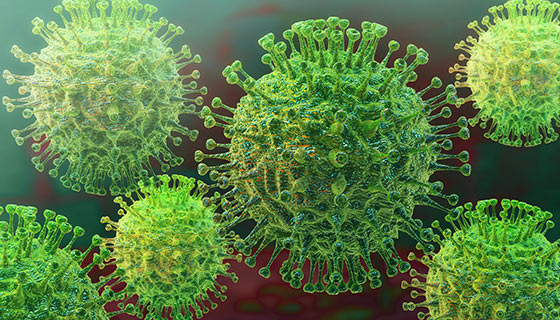
Some Scientists 'Uneasy' About the Race For a Covid-19 Vaccine (theguardian.com)
The Guardian ran an article by the author of Pale Rider: The Spanish Flu of 1918 and How It Changed the World looking at problems with our own race for a vaccine in 2020:On 2 August, Steven Salzberg, a computational biologist at Johns Hopkins University in Baltimore, Maryland, suggested in Forbes magazine that a promising vaccine be rolled out to a wider pool of volunteers before clinical trials had been completed, triggering an outcry (and some sympathy) that prompted him to recant the next day. Meanwhile, a research group with links to Harvard University continues to defend its publication in July of a recipe for a do-it-yourself Covid-19 vaccine — one that only the group's 20-odd members had previously tested...
The accumulation of such incidents has left many scientists feeling deeply uneasy. "I'm more and more concerned that things are getting done in a rush," says Beate Kampmann, who directs the Vaccine Centre at the London School of Hygiene and Tropical Medicine (and whose work email account was subject to a failed hack in July). On 13 August, the editor-in-chief of the journal Science issued a call to order. "Short cuts in testing for vaccine safety and efficacy endanger millions of lives in the short term and will damage public confidence in vaccines and in science for a long time to come," wrote H Holden Thorp.
He went on to point out that the stakes are higher than with unproven therapies such as hydroxychloroquine, because a vaccine is given to healthy people. "Approval of a vaccine that is harmful or isn't effective could be leveraged by political forces that already propagate vaccine fears," he warned... Kampmann, meanwhile, feels it's important not to let the recent shenanigans in the vaccine community overshadow its huge achievements. If current forecasts are correct, a Covid-19 vaccine will be available in 2021 — smashing all records for vaccine development — and there will be many more reasons to trust it than not to. Still, those with their eye on that glittering prize should remember what is at stake. "We have to be careful," she says, "because what we do with Covid-19 could have repercussions for trust in all vaccine programs."
https://science.slashdot.org/story/20/09/01/2148205/us-says-it-wont-join-who-linked-effort-to-develop-distribute-coronavirus-vaccine
https://science.slashdot.org/story/20/09/04/2059240/results-of-russias-covid-19-vaccine-produced-antibody-response

The accumulation of such incidents has left many scientists feeling deeply uneasy. "I'm more and more concerned that things are getting done in a rush," says Beate Kampmann, who directs the Vaccine Centre at the London School of Hygiene and Tropical Medicine (and whose work email account was subject to a failed hack in July). On 13 August, the editor-in-chief of the journal Science issued a call to order. "Short cuts in testing for vaccine safety and efficacy endanger millions of lives in the short term and will damage public confidence in vaccines and in science for a long time to come," wrote H Holden Thorp.
He went on to point out that the stakes are higher than with unproven therapies such as hydroxychloroquine, because a vaccine is given to healthy people. "Approval of a vaccine that is harmful or isn't effective could be leveraged by political forces that already propagate vaccine fears," he warned... Kampmann, meanwhile, feels it's important not to let the recent shenanigans in the vaccine community overshadow its huge achievements. If current forecasts are correct, a Covid-19 vaccine will be available in 2021 — smashing all records for vaccine development — and there will be many more reasons to trust it than not to. Still, those with their eye on that glittering prize should remember what is at stake. "We have to be careful," she says, "because what we do with Covid-19 could have repercussions for trust in all vaccine programs."
https://science.slashdot.org/story/20/09/01/2148205/us-says-it-wont-join-who-linked-effort-to-develop-distribute-coronavirus-vaccine
US Says It Won't Join WHO-Linked Effort To Develop, Distribute Coronavirus Vaccine (washingtonpost.com)
The Trump administration said it will not join a global effort to develop, manufacture and equitably distribute a coronavirus vaccine, in part because the World Health Organization is involved, a decision that could shape the course of the pandemic and the country's role in health diplomacy. The Washington Post reports:More than 170 countries are in talks to participate in the Covid-19 Vaccines Global Access (Covax) Facility, which aims to speed vaccine development and secure doses for all countries and distribute them to the most high-risk segment of each population. The plan, which is co-led by the WHO, the Coalition for Epidemic Preparedness Innovations and Gavi, the vaccine alliance, was of interest to some members of the Trump administration and is backed by traditional U.S. allies, including Japan, Germany and the European Commission, the executive arm of the European Union.
But the United States will not participate, in part because the White House does not want to work with the WHO, which President Trump has criticized over what he characterized as its "China-centric" response to the pandemic. "The United States will continue to engage our international partners to ensure we defeat this virus, but we will not be constrained by multilateral organizations influenced by the corrupt World Health Organization and China," said Judd Deere, a spokesman for the White House. The Covax decision, which has not been previously reported, is effectively a doubling down by the administration on its bet that the United States will win the vaccine race. It eliminates the chance to secure doses from a pool of promising vaccine candidates -- a potentially risky strategy.
But the United States will not participate, in part because the White House does not want to work with the WHO, which President Trump has criticized over what he characterized as its "China-centric" response to the pandemic. "The United States will continue to engage our international partners to ensure we defeat this virus, but we will not be constrained by multilateral organizations influenced by the corrupt World Health Organization and China," said Judd Deere, a spokesman for the White House. The Covax decision, which has not been previously reported, is effectively a doubling down by the administration on its bet that the United States will win the vaccine race. It eliminates the chance to secure doses from a pool of promising vaccine candidates -- a potentially risky strategy.
Results of Russia's COVID-19 Vaccine Produced Antibody Response (reuters.com)
Russia's "Sputnik-V" COVID-19 vaccine produced an antibody response in all participants in early-stage trials, according to results published on Friday by The Lancet medical journal that were hailed by Moscow as an answer to its critics. Reuters reports:The results of the two trials, conducted in June-July this year and involving 76 participants, showed 100% of participants developing antibodies to the new coronavirus and no serious side effects, The Lancet said. Russia licensed the two-shot jab for domestic use in August, the first country to do so and before any data had been published or a large-scale trial begun. "The two 42-day trials -- including 38 healthy adults each -- did not find any serious adverse effects among participants, and confirmed that the vaccine candidates elicit an antibody response," The Lancet said. "Large, long-term trials including a placebo comparison, and further monitoring are needed to establish the long-term safety and effectiveness of the vaccine for preventing COVID-19 infection," it said.
The vaccine is named Sputnik-V in homage to the world's first satellite, launched by the Soviet Union. Some Western experts have warned against its use until all internationally approved testing and regulatory steps have been taken. But with the results now published for the first time in an international peer-reviewed journal, and with a 40,000-strong later-stage trial launched last week, a senior Russian official said Moscow had faced down its critics abroad. "With this (publication) we answer all of the questions of the West that were diligently asked over the past three weeks, frankly with the clear goal of tarnishing the Russian vaccine," said Kirill Dmitriev, the head of the Russian Direct Investment Fund (RDIF), Russia's sovereign wealth fund, which has backed the vaccine. "All of the boxes are checked," he told Reuters. "Now... we will start asking questions of some of the Western vaccines."
The vaccine is named Sputnik-V in homage to the world's first satellite, launched by the Soviet Union. Some Western experts have warned against its use until all internationally approved testing and regulatory steps have been taken. But with the results now published for the first time in an international peer-reviewed journal, and with a 40,000-strong later-stage trial launched last week, a senior Russian official said Moscow had faced down its critics abroad. "With this (publication) we answer all of the questions of the West that were diligently asked over the past three weeks, frankly with the clear goal of tarnishing the Russian vaccine," said Kirill Dmitriev, the head of the Russian Direct Investment Fund (RDIF), Russia's sovereign wealth fund, which has backed the vaccine. "All of the boxes are checked," he told Reuters. "Now... we will start asking questions of some of the Western vaccines."

https://www.wonkette.com/trump-retweets-covidiots-bizarre-claim-that-only-6-of-covid-19-deaths-are-real
In which Dr. Fauci must explain for the president that no, in fact, coronavirus has NOT killed only 9,000 people. — Crooks and Liars
It can also wreck your heart even if you haven't had any symptoms. (Scientific American)

https://science.slashdot.org/story/20/09/02/0538229/a-supercomputer-analyzed-covid-19-and-an-interesting-new-hypothesis-has-emerged
A Supercomputer Analyzed COVID-19, and an Interesting New Hypothesis Has Emerged (medium.com)
Thelasko shares a report from Medium:Earlier this summer, the Summit supercomputer at Oak Ridge National Lab in Tennessee set about crunching data on more than 40,000 genes from 17,000 genetic samples in an effort to better understand Covid-19. Summit is the second-fastest computer in the world, but the process -- which involved analyzing 2.5 billion genetic combinations -- still took more than a week. When Summit was done, researchers analyzed the results. It was, in the words of Dr. Daniel Jacobson, lead researcher and chief scientist for computational systems biology at Oak Ridge, a 'eureka moment.' The computer had revealed a new theory about how Covid-19 impacts the body: the bradykinin hypothesis. The hypothesis provides a model that explains many aspects of Covid-19, including some of its most bizarre symptoms. It also suggests 10-plus potential treatments, many of which are already FDA approved. Jacobson's group published their results in a paper in the journal eLife in early July.
According to the team's findings, a Covid-19 infection generally begins when the virus enters the body through ACE2 receptors in the nose, (The receptors, which the virus is known to target, are abundant there.) The virus then proceeds through the body, entering cells in other places where ACE2 is also present: the intestines, kidneys, and heart. This likely accounts for at least some of the disease's cardiac and GI symptoms. But once Covid-19 has established itself in the body, things start to get really interesting. According to Jacobson's group, the data Summit analyzed shows that Covid-19 isn't content to simply infect cells that already express lots of ACE2 receptors. Instead, it actively hijacks the body's own systems, tricking it into upregulating ACE2 receptors in places where they're usually expressed at low or medium levels, including the lungs.
The renin-angiotensin system (RAS) controls many aspects of the circulatory system, including the body's levels of a chemical called bradykinin, which normally helps to regulate blood pressure. According to the team's analysis, when the virus tweaks the RAS, it causes the body's mechanisms for regulating bradykinin to go haywire. Bradykinin receptors are resensitized, and the body also stops effectively breaking down bradykinin. (ACE normally degrades bradykinin, but when the virus downregulates it, it can't do this as effectively.) The end result, the researchers say, is to release a bradykinin storm -- a massive, runaway buildup of bradykinin in the body. According to the bradykinin hypothesis, it's this storm that is ultimately responsible for many of Covid-19's deadly effects.Several drugs target aspects of the RAS and are already FDA approved, including danazol, stanozolol, and ecallantide, which reduce bradykinin production and could potentially stop a deadly bradykinin storm.
Interestingly, the researchers suggest vitamin D as a potentially useful Covid-19 drug. "The vitamin is involved in the RAS system and could prove helpful by reducing levels of another compound, known as REN," the report says. "Again, this could stop potentially deadly bradykinin storms from forming." Other compounds could treat symptoms associated with bradykinin storms, such as Hymecromone and timbetasin.
According to the team's findings, a Covid-19 infection generally begins when the virus enters the body through ACE2 receptors in the nose, (The receptors, which the virus is known to target, are abundant there.) The virus then proceeds through the body, entering cells in other places where ACE2 is also present: the intestines, kidneys, and heart. This likely accounts for at least some of the disease's cardiac and GI symptoms. But once Covid-19 has established itself in the body, things start to get really interesting. According to Jacobson's group, the data Summit analyzed shows that Covid-19 isn't content to simply infect cells that already express lots of ACE2 receptors. Instead, it actively hijacks the body's own systems, tricking it into upregulating ACE2 receptors in places where they're usually expressed at low or medium levels, including the lungs.
The renin-angiotensin system (RAS) controls many aspects of the circulatory system, including the body's levels of a chemical called bradykinin, which normally helps to regulate blood pressure. According to the team's analysis, when the virus tweaks the RAS, it causes the body's mechanisms for regulating bradykinin to go haywire. Bradykinin receptors are resensitized, and the body also stops effectively breaking down bradykinin. (ACE normally degrades bradykinin, but when the virus downregulates it, it can't do this as effectively.) The end result, the researchers say, is to release a bradykinin storm -- a massive, runaway buildup of bradykinin in the body. According to the bradykinin hypothesis, it's this storm that is ultimately responsible for many of Covid-19's deadly effects.Several drugs target aspects of the RAS and are already FDA approved, including danazol, stanozolol, and ecallantide, which reduce bradykinin production and could potentially stop a deadly bradykinin storm.
Interestingly, the researchers suggest vitamin D as a potentially useful Covid-19 drug. "The vitamin is involved in the RAS system and could prove helpful by reducing levels of another compound, known as REN," the report says. "Again, this could stop potentially deadly bradykinin storms from forming." Other compounds could treat symptoms associated with bradykinin storms, such as Hymecromone and timbetasin.

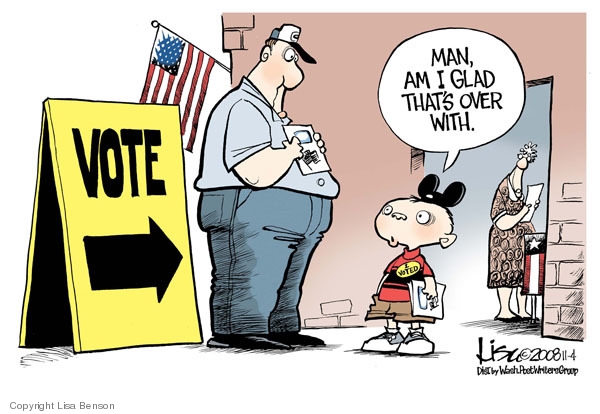

ELECTION 2020
 |
| Bendik Kaltenborn for The Washington Post |
https://www.washingtonpost.com/outlook/2020/09/03/trump-stay-in-office/?arc404=true
What’s the worst that
could happen?
The election will likely spark violence — and a constitutional
crisis
SEPTEMBER 3, 2020
We wanted to know: What’s the worst thing that could happen to our country during the presidential election? President Trump has broken countless norms and ignored countless laws during his time in office, and while my colleagues and I at the Transition Integrity Project didn’t want to lie awake at night contemplating the ways the American experiment could fail, we realized that identifying the most serious risks to our democracy might be the best way to avert a November disaster. So we built a series of war games, sought out some of the most accomplished Republicans, Democrats, civil servants, media experts, pollsters and strategists around, and asked them to imagine what they’d do in a range of election and transition scenarios.
A landslide for Joe Biden resulted in a relatively orderly transfer of power. Every other scenario we looked at involved street-level violence and political crisis.
Picture this: On the morning of Election Day, false stories appear online claiming that Biden has been hospitalized with a life-threatening heart attack and the election has been delayed. Every mainstream news organization reports that the rumors are unfounded, but many Biden supporters, confused by the bogus claims, stay home.
Still, by late that night, most major networks have called the election for Biden: The former vice president has won key states and has a slender lead in the national popular vote, and polling experts predict that his lead will grow substantially as Western states count an unusually high number of mail-in ballots. The electoral college looks secure for Biden, too.
But Trump refuses to concede, alleging on Twitter that “MILLIONS of illegal ALIENS and DEAD PEOPLE” have voted in large numbers and that the uncounted ballots are all “FAKE VOTES!!!” Social media fills with posts from Trump supporters alleging that the election has been “stolen” in a “Deep State coup,” and Trump-friendly pundits on Fox News and OAN echo the message.
Soon, Attorney General William P. Barr opens an investigation into unsubstantiated allegations of massive vote-by-mail fraud and ties between Democratic officials and antifa. In Michigan and Wisconsin, where Biden has won the official vote and Democratic governors have certified slates of pro-Biden electors, the Trump campaign persuades Republican-controlled legislatures to send rival pro-Trump slates to Congress for the electoral college vote.
The next week is chaotic: A list of Michigan and Wisconsin electors for Biden circulates on right-wing social media, including photos, home addresses and false claims that scores of them are in the pay of billionaire George Soros or have been linked to child sex-trafficking rings.
Massive pro-Biden street protests begin, demanding that Trump concede. The president tweets that “REAL PATRIOTS MUST SHOW THESE ANTIFA TERRORISTS THAT CITIZENS WHO LOVE THE 2ND AMENDMENT WILL NEVER LET THEM STEAL THIS ELECTION!!!” Around the nation, violent clashes erupt. Several people are injured and killed in multiple incidents, though reports conflict about their identities and who started the violence.
Meanwhile, Trump declares that “UNLESS THIS CARNAGE ENDS NOW,” he will invoke the Insurrection Act and send “Our INCREDIBLY POWERFUL MILITARY and their OMINOUS WEAPONS” into the streets to “Teach these ANTI-AMERICAN TERRORISTS A LESSON.” At the Pentagon, the Joint Chiefs of Staff convene a hurried meeting to discuss the crisis.
And it’s not even Thanksgiving yet.
 |
| Supporters of President Trump await his Republican National Convention speech at a watch party near Dripping Springs, Tex., on Aug. 27. (Sergio Flores for The Washington Post) |
With the exception of the “big Biden win” scenario, each of our exercises reached the brink of catastrophe, with massive disinformation campaigns, violence in the streets and a constitutional impasse. In two scenarios (“Trump win” and “extended uncertainty”) there was still no agreement on the winner by Inauguration Day, and no consensus on which candidate should be assumed to have the ability to issue binding commands to the military or receive the nuclear codes. In the “narrow Biden win” scenario, Trump refused to leave office and was ultimately escorted out by the Secret Service — but only after pardoning himself and his family and burning incriminating documents.
For obvious reasons, we couldn’t ask Trump or Biden — or their campaign aides — to play themselves in these exercises, so we did the next best thing: We recruited participants with similar backgrounds. On the GOP side, our “players” included former Republican National Committee chairman Michael Steele, conservative commentator Bill Kristol and former Kentucky secretary of state Trey Grayson. On the Democratic side, participants included John Podesta, chair of Hillary Clinton’s 2016 presidential campaign and a top White House adviser to Bill Clinton and Barack Obama; Donna Brazile, the campaign chair for Al Gore’s 2000 presidential run; and Jennifer Granholm, former governor of Michigan. Other participants included political strategists, journalists, polling experts, tech and social media experts, and former career officials from the intelligence community, the Justice Department, the military and the Department of Homeland Security.
In each scenario, Team Trump — the players assigned to simulate the Trump campaign and its elected and appointed allies — was ruthless and unconstrained right out of the gate, and Team Biden struggled to get out of reaction mode. In one exercise, for instance, Team Trump’s repeated allegations of fraudulent mail-in ballots led National Guard troop to destroy thousands of ballots in Democratic-leaning ZIP codes, to applause on social media from Trump supporters. Over and over, Team Biden urged calm, national unity and a fair vote count, while Team Trump issued barely disguised calls for violence and intimidation against ballot-counting officials and Biden electors.
In every exercise, both teams sought to mobilize their supporters to take to the streets. Team Biden repeatedly called for peaceful protests, while Team Trump encouraged provocateurs to incite violence, then used the resulting chaos to justify sending federalized Guard units or active-duty military personnel into American cities to “restore order,” leading to still more violence. (The exercises underscored the tremendous power enjoyed by an incumbent president: Biden can call a news conference, but Trump can call in the 82nd Airborne.)
Similarly, Team Trump repeatedly attempted to exploit ambiguities and gaps in the legal framework. (There are more than you might think.) Team Trump repeatedly sought, for instance, to persuade state GOP allies to send rival slates of electors to Congress when the popular vote didn’t go its way. With competing slates heading to Washington for the Jan. 6 joint session of Congress that formally counts the electoral votes, Trump supporters argued that Vice President Pence, in his capacity as president of the Senate, had the power to decide which electors to recognize. In contrast, Democrats argued that the House of Representatives had the constitutional authority to choose which electors should be accepted in the event of a deadlock — or, alternatively, the ability to prevent the joint session from taking place at all. (We didn’t resolve this kind of standoff in our exercises; it’s not clear how such a stalemate would be settled in real life.)
In the “Trump win” scenario, desperate Democrats — stunned by yet another election won by the candidate with fewer votes after credible claims of foreign interference and voter suppression — also sought to send rival slates of electors to Congress. They even floated the idea of encouraging secessionist movements in California and the Pacific Northwest unless GOP congressional leaders agreed to a series of reforms, including the division of California into five smaller states to ensure better Senate representation of its vast population, and statehood for D.C. and Puerto Rico.
While both parties appealed to the courts as well as to public opinion, the legal experts in our exercises pointed out that the judicial system might well avoid rendering decisions on the central issues, since courts might see them as fundamentally political, rather than judicial, in nature. Other players noted that there was, in any case, no guarantee that the losing side would accept a ruling from a highly politicized Supreme Court.
 |
| National Guard troops line up outside the White House on June 2. President Trump has at times threatened to use the military to quell unrest in American cities. (Evelyn Hockstein for The Washington Post) |
First and foremost, congressional and state leaders, including legislators, governors, state secretaries of state and state attorneys general from both parties, can commit to protecting the integrity of the electoral process against partisan meddling. State officials can ensure that voters have detailed, accurate and timely information about where, when and how to vote, and make sure they understand that nobody can cancel or postpone the election. State officials can also eliminate administrative hurdles that may prevent voters from meeting mail-in ballot deadlines through no fault of their own, and recruit enough poll workers to ensure that all voters can vote and all ballots can be counted. Finally, they can take steps to protect the election officials who manage vote counting from harassment and intimidation attempts, and establish — in advance and on a bipartisan basis — standards for adjudicating any competing claims about how to allocate a state’s electoral votes.
Meanwhile, military and law enforcement leaders can prepare for the possibility that politicians will seek to manipulate or misuse their coercive powers. Partisans, including Trump, may try to deploy law enforcement, National Guard troops and, potentially, active-duty military personnel to “restore order” in a manner that primarily benefits one party, or involve troops and law enforcement in efforts to interrupt the ballot-counting process. The federal response to this summer’s protests in D.C.’s Lafayette Square and Portland, Ore., suggests that this is not purely speculative. To avoid becoming unwitting pawns in a partisan battle, military and law enforcement leaders can issue clear advance statements about what they will and won’t do. They can train troops and police officers on de-escalation techniques and on the vital need to remain nonpartisan and respectful of civil liberties.
The media also has an important role. Responsible outlets can help educate the public about the possibility — indeed, the likelihood — that there won’t be a clear winner on election night because an accurate count may take weeks, given the large number of mail-in ballots expected in this unprecedented mid-pandemic election. Journalists can also help people understand that voter fraud is extraordinarily rare, and, in particular, that there’s nothing nefarious about voting by mail. Social media platforms can commit to protecting the democratic process, by rapidly removing or correcting false statements spread by foreign or domestic disinformation campaigns and by ensuring that their platforms aren’t used to incite or plan violence.
 |
| A woman shows her support for Joe Biden in front of the White House on Aug. 29. (Salwan Georges/The Washington Post) |
Finally, ordinary citizens can help, too — perhaps most of all. As the jurist Learned Hand said in 1944, “Liberty lies in the hearts of men and women; when it dies there, no constitution, no law, no court can save it . . . while it lies there, it needs no constitution, no law, no court to save it.” This is as true now as it was then: When people unite to demand democracy and the rule of law, even repressive regimes can be stopped in their tracks. Mass mobilization is no guarantee that our democracy will survive — but if things go as badly as our exercises suggest they might, a sustained, nonviolent protest movement may be America’s best and final hope.
https://www.washingtonpost.com/politics/2020/09/04/white-house-racial-sensitivity-training/
White House directs federal agencies to cancel race-related training sessions it calls ‘un-American propaganda’
Administration seeks list of contracts for those that refer to ‘white privilege,’ according to memo
President Trump is moving to revamp federal agencies’ racial sensitivity trainings, casting some of them as “divisive” and “un-American,” according to a memo by the White House Office of Management and Budget.




https://www.wonkette.com/more-us-troops-are-riding-with-biden-than-saluting-president-bone-spurs





"GIIIIIIIINA" = CHINA
https://www.wonkette.com/for-sadly-not-the-last-time-giiiiiiina-isnt-doing-sh-t-to-help-joe-biden

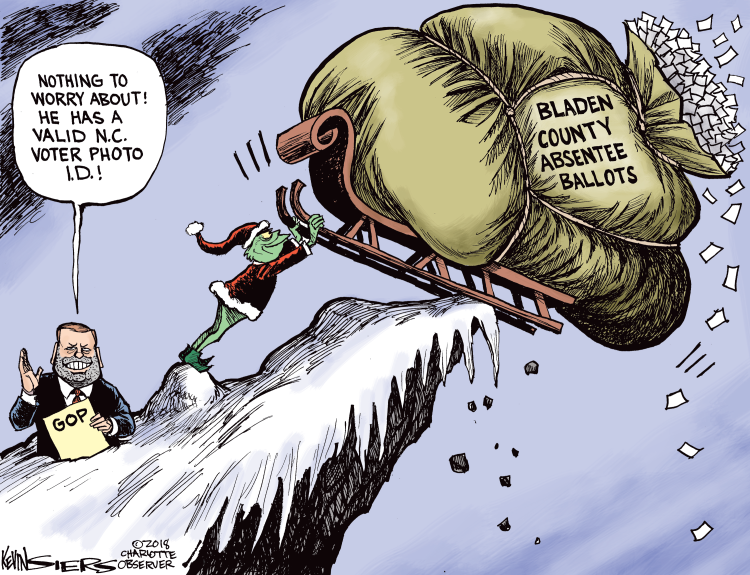
https://reason.com/2020/09/03/fosta-is-unconstitutional-argue-sexual-freedom-advocates-and-first-amendment-lawyers-in-new-motion/
Meanwhile, the SAFE SEX Workers Study Act, introduced by Rep. Ro Khanna (D-Calif.) to pave the way for FOSTA's dismantling, has gone nowhere since its introduction last December. Several civil lawsuits—two against Craigslist and one against Mailchimp—are invoking FOSTA in order to accuse these tech companies of being legally liable for "sex trafficking."
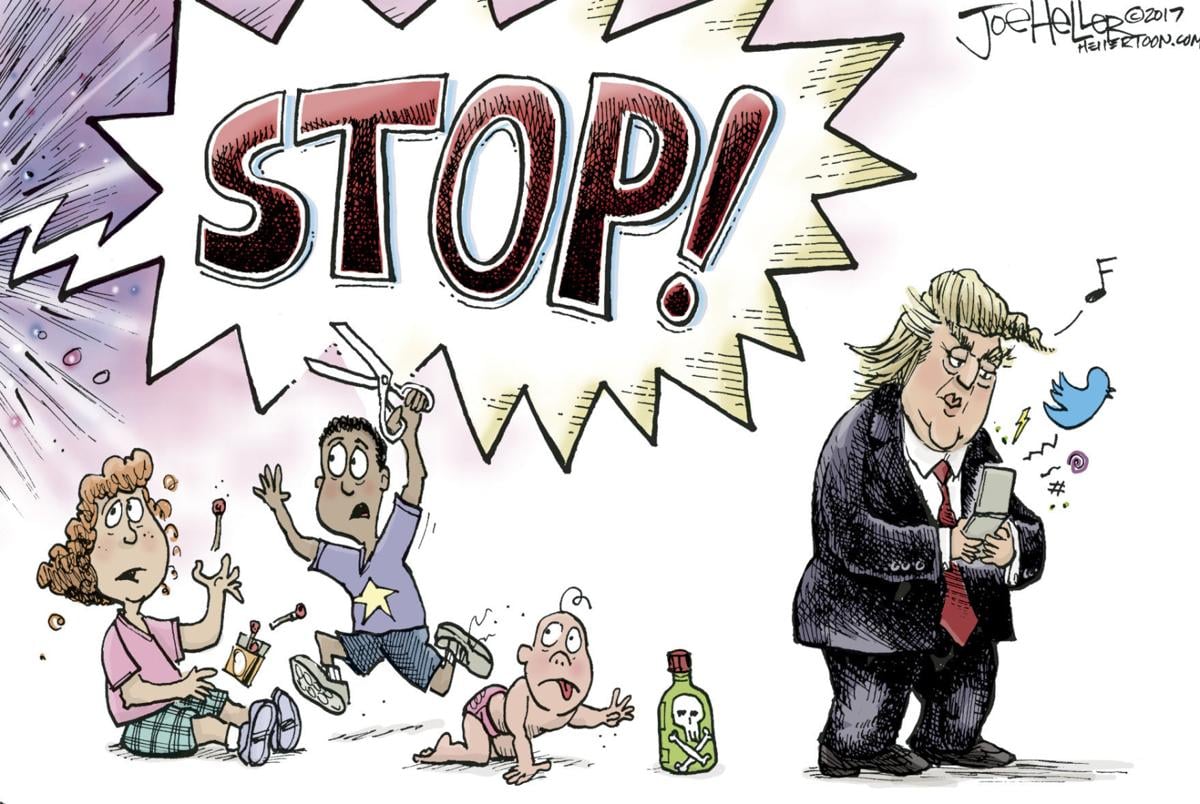

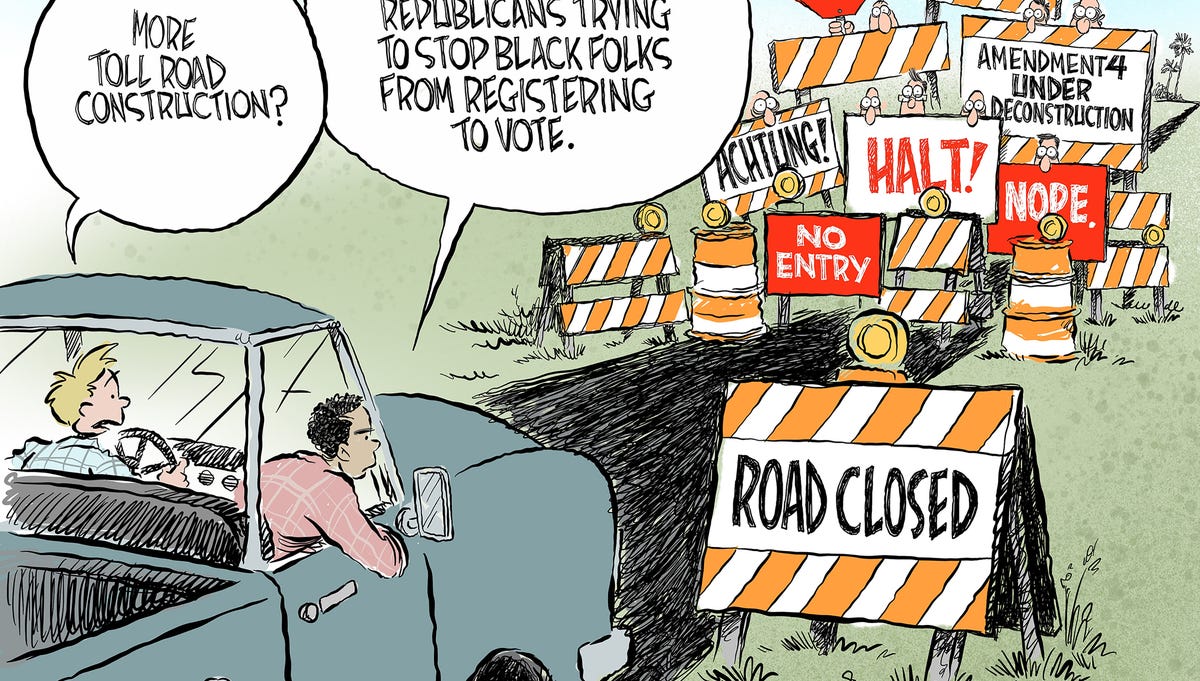
https://www.wonkette.com/trump-administration-releases-still-more-census-f-ckery-worst-anthology-ever
https://www.wonkette.com/bill-bar-just-a-big-ol-liar-about-absentee-voter-fraud-who-knew
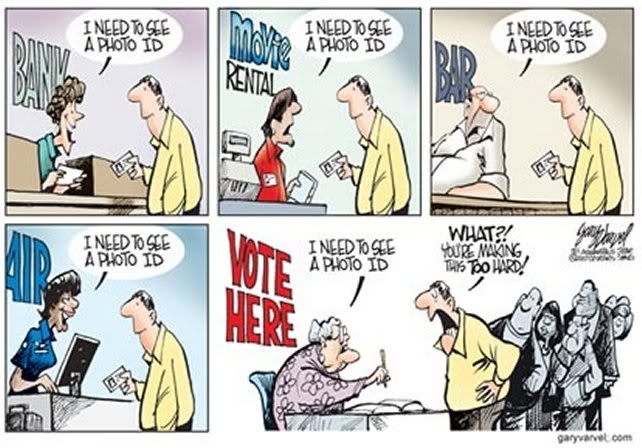

/cdn.vox-cdn.com/uploads/chorus_image/image/64593850/700488105.0.jpg)
RANDOM

https://www.damemagazine.com/
In July, The Washington Post estimated that, as president, Donald J. Trump has told about 20,000 lies. In a press conference on August 8, Trump betrayed the truth yet again, and he got called on it. He gloated about his administration having passed the Veterans Choice Act, a piece of legislation that made it possible for veterans to use their government health benefits at providers other than VA hospitals. In reality, it was signed into law by former President Barack Obama.

https://www.wired.com/story/how-to-solve-a-rubiks-cube-in-5-seconds-or-less/

https://www.wired.com/story/even-huge-molecules-follow-the-quantum-worlds-bizarre-rules/


https://www.wonkette.com/christians-against-dinosaurs-group-fails-to-force-arizona-t-rex-into-extinction




https://politics.slashdot.org/story/20/09/01/2218212/microsoft-releases-deepfake-detection-tool-ahead-of-election
https://entertainment.slashdot.org/story/20/09/01/2229238/ufo-sightings-are-up-51-amid-coronavirus-data-shows
https://hardware.slashdot.org/story/20/09/01/2238222/silicon-sandwiches-make-for-lightweight-high-capacity-batteries
NEW THINGS TO READ
https://www.nytimes.com/2017/11/28/books/review/reckless-daughter-david-yaffe-biography-joni-mitchell.html

+++++++++++++++++++++++++++++++++++++++++++++++++++++++++++++++++++++++
+++++++++++++++++++++++++++++++++++++++++++++++++++++++++++++++++++++++
+++++++++++++++++++++++++++++++++++++++++++++++++++++++++++++++++++++++
- Bloggery committed by chris tower - 2009.05 - 10:10
- Days ago = 1891 days ago
- New note - On 1807.06, I ceased daily transmission of my Hey Mom feature after three years of daily conversations. I plan to continue Hey Mom posts at least twice per week but will continue to post the days since ("Days Ago") count on my blog each day. The blog entry numbering in the title has changed to reflect total Sense of Doubt posts since I began the blog on 0705.04, which include Hey Mom posts, Daily Bowie posts, and Sense of Doubt posts. Hey Mom posts will still be numbered sequentially. New Hey Mom posts will use the same format as all the other Hey Mom posts; all other posts will feature this format seen here.

 |
| The president with members of his family on the final night of the Republican convention last month. Some fear that Trump may not concede if he loses the election in November. (Jabin Botsford/The Washington Post) |
White House directs federal agencies to cancel race-related training sessions it calls ‘un-American propaganda’
Administration seeks list of contracts for those that refer to ‘white privilege,’ according to memo
September 5, 2020 at 7:52 a.m. PDT
The memo, released on Friday, also tells all federal agencies to identify and if possible cancel contracts that involve teaching that America is an “inherently racist or evil country.”
“The President has directed me to ensure that federal agencies cease and desist from using taxpayer dollars to fund these divisive, un-American propaganda training sessions,” the memo states.


STATEMENT: A Message from State Board Executive Director Karen Brinson Bell to NC Voters#ncpol #YourVoteCountsNC pic.twitter.com/eDdXBuAhxV— NCSBE (@NCSBE) September 3, 2020
Today, President Trump outrageously encouraged NCians to break the law in order to help him sow chaos in our election. Make sure you vote, but do NOT vote twice! I will do everything in my power to make sure the will of the people is upheld in November.— Josh Stein (@JoshStein_) September 2, 2020
Trump suggests that people in North Carolina stress-test the security of their elections systems by voting twice — an act that constitutes the kind of voter fraud the president has railed against. @maggieNYT @stefsaul https://t.co/F0wg0fjHPN— Peter Baker (@peterbakernyt) September 3, 2020


https://www.wonkette.com/more-us-troops-are-riding-with-biden-than-saluting-president-bone-spurs





"GIIIIIIIINA" = CHINA
https://www.wonkette.com/for-sadly-not-the-last-time-giiiiiiina-isnt-doing-sh-t-to-help-joe-biden


https://reason.com/2020/09/03/fosta-is-unconstitutional-argue-sexual-freedom-advocates-and-first-amendment-lawyers-in-new-motion/
The Woodhull Freedom Foundation is suing (again) to get FOSTA ruled unconstitutional. FOSTA—the 2018 "human trafficking" law making it a federal crime to host digital content that promotes prostitution—violates the First and Fifth Amendments, says Woodhull's motion for summary judgment, filed in federal court on August 31. It also takes aim at the law's retroactive scope—FOSTA says you can be punished for violating it even before the law went into effect.
The suit comes after a federal district court dismissed an earlier filing against FOSTA, brought by Woodhull—a nonprofit dedicated "to affirm[ing] and protect[ing] sexual freedom as a fundamental human right"—and fellow plaintiffs The Internet Archive, Human Rights Watch, Eric Koszyk, and Alex Andrews. In January, a federal appeals court reversed the decision and sent the case back to the district court.
You can find their full motion for summary judgment here (and find previous court filings here). "Plaintiffs request a declaratory ruling that FOSTA is unconstitutional and a permanent injunction against its enforcement and application," the motion states. They claim that "FOSTA is unconstitutionally vague and overbroad, is a content-based statute that cannot satisfy strict scrutiny, and lacks the necessary scienter requirements to be constitutional" (scienter refers to a person's intent when doing something that the government claims is criminal). "And it explicitly is meant to have retroactive reach in both its criminal and civil applications."
Meanwhile, the SAFE SEX Workers Study Act, introduced by Rep. Ro Khanna (D-Calif.) to pave the way for FOSTA's dismantling, has gone nowhere since its introduction last December. Several civil lawsuits—two against Craigslist and one against Mailchimp—are invoking FOSTA in order to accuse these tech companies of being legally liable for "sex trafficking."



https://www.wonkette.com/trump-administration-releases-still-more-census-f-ckery-worst-anthology-ever
https://www.wonkette.com/bill-bar-just-a-big-ol-liar-about-absentee-voter-fraud-who-knew
Bill Barr Just A Big Ol' Liar About Absentee Voter Fraud, Who Knew?


/cdn.vox-cdn.com/uploads/chorus_image/image/64593850/700488105.0.jpg)
RANDOM

https://www.damemagazine.com/
In July, The Washington Post estimated that, as president, Donald J. Trump has told about 20,000 lies. In a press conference on August 8, Trump betrayed the truth yet again, and he got called on it. He gloated about his administration having passed the Veterans Choice Act, a piece of legislation that made it possible for veterans to use their government health benefits at providers other than VA hospitals. In reality, it was signed into law by former President Barack Obama.
Trump’s August 8 press conference was held at his golf club in Bedminster, New Jersey. The Real Deal estimates that it costs $350,000 to join.
“I’ve just signed two bills that are great for our vets,” Trump announced to the crowd, which included members of the golf club. “Our vets are very special. We passed Choice, as you know, Veterans Choice, and Veterans Accountability. They’ve been trying to get that passed for decades and decades and decades, and no president has ever been able to do it. And we got it done.”
“Why do you keep saying you passed Veterans Choice?” called out CBS News correspondent Paula Reid.
When Trump ignored her and tried to call on another reporter, members of the golf club cheered loudly.
Reid tried again: “You said that you passed Veterans Choice. It was passed in 2014.” [Inaudible because of more cheers] ” … It was a false statement, sir.”
The new round of cronies’ cheers had nearly drowned her out. Trump seemed to recognize the commotion as an opportunity for him to escape a tough moment to buoyant sounds. As he walked off the stage, his band joyfully played the opening notes of the bubbly disco hit “YMCA”—which the co-founder of the Village People has asked him not to play.
Reid gets plenty of points for her insistence. According to CNN, she may be the first reporter to challenge Trump’s alternate fact about that particular Act. That alone is remarkable, considering CNN estimates Trump has claimed credit for the Veterans Choice Act 150 times.
Why haven’t reporters routinely challenged Trump on this claim? Why didn’t his loyalists take issue with his declaration a few days later that former Vice-President Joe Biden will “hurt the Bible, hurt God”? Why does any American believe Trump about anything, given that his lies rain like a plague of frogs from heaven?
One answer may be that it is part of human nature to embrace as possible ideas that are clearly improbable. How else to explain children’s belief that a big, round man can slip down their chimneys on Christmas Eve? Or Catholics’ belief that, more than 2,000 years ago, a virgin gave birth to a boy whom, all these years after his death, people “eat” in ritual gatherings? What about the Mormon idea that the as-yet-undiscovered planet Kolob is the single planet geographically closest to God’s throne? What about the smokers who discount the odds that tobacco can kill them? What about the people who believe that, even though face masks stop the spread of the droplets that carry SARS-CoV-2, masks won’t stop the spread of the disease the virus causes?
How and Why We Believe the Unbelievable
Psychologists credit common, unconscious, cognitive tricks for people’s ability to perform the psychological jujutsu necessary to temporarily misplace their reason.
- Cognitive dissonance describes the psychological distress caused by trying to consider as true two very inconsistent statements. For example, “Trump always tells it like it is” is psychologically inconsistent with “Trump has repeatedly lied about signing the Veterans Choice Act.” To rid themselves of the discomfort caused by the dissonance, people either toss out one of the pieces of information or interpret one or both in a new way. “Trump has repeatedly lied” might get tossed, in which case “Trump always tells it like it is” can stay.
- Confirmation bias (a.k.a. “my side bias”) describes people’s reluctance even to take into consideration information that is discordant with their beliefs. When they are cognitively biased, people welcome only intelligence that tells them they’ve been right all along.
These two by no means constitute an exhaustive list of the ways people fool themselves. By and large, they can be grouped under the rubric motivated reasoning, which means constructing and evaluating arguments in ways that bring about a preferred conclusion. Motivated reasoning assures people that they are fundamentally in command of important facts. That in and of itself comes with such a huge, energy-saving upside that it may be coded into human DNA. Early humans who relied on motivated reasoning wouldn’t have needed to hide every single time they saw a swaying blade of savanna grass. They might instead have assured themselves, for example, that “Nah, lions don’t hunt at noon” and gone about gathering roots, which they needed to do lest they starve.
As useful as motivated reasoning may always have been to humans, in the modern world it can easily lead voters far afield of the truth. This can happen to the great satisfaction of politicians who lie.
Which, of course, many do.
The Good Old Days of the Good Old Lies
As Daniel Ellsberg’s Pentagon Papers revealed, former President Richard Nixon lied to conceal the late-1960s “secret war” in Cambodia and Laos. Nixon also lied when claiming he had nothing to do with the cover-up of the Watergate break-in. And former President George H. W. Bush’s lie that he deployed troops to the Gulf in 1990 to “assist Saudi Arabia in the defense of its homeland” was revealed when a St. Petersburg Times reporter obtained a satellite photo showing only an empty desert where the White House claimed 250,000 Iraqi troops and 1,500 tanks were swarming.
Those lies cost hundreds of thousands of lives. Even so, they represent a time when lies seemed, well, more reliable than they do now.
Jason Stanley is a professor of philosophy at Yale University and author of the 2018 book How Fascism Works: The Politics of Us and Them. According to Stanley, the fascist political playbook calls for lies of a different sort than American politicians typically use. Where Bush and Nixon lied to conceal what they’d done and why, fascist politicians also use lies to convince a susceptible population they are exceptional and other nations, religions, or races are holding them back from glorious destinies.
Fascist politicians then create an entirely new reality that matches the lie.
For example, Adolf Hitler bathed his Christian followers in Poland in tales of how superior they were to the Jews, who he said were filthy and homeless and conspiring to keep Christians from the future they deserved. Then, he took away the homes of Warsaw’s Jews and crowded them into a ghetto, where he starved them. As they died dirty and homeless in the streets, he sent documentary crews. The images of emaciated Jews in tattered clothing expiring here and there made them as a group look scary to Hitler’s Christian followers in precisely the way Hitler wanted.
In a conversation regarding the current Trump presidential campaign, Stanley pointed out ways in which our president leans on some of Hitler’s rhetorical tricks. Trump pits ethnicities and racial groups against each other. He implies that people of his own heritage (white) deserve more than they’re currently getting, and that certain villains (immigrants) are standing in their way. And if he’s not directly abetting QAnon’s “deep state” stories of conspiracies by shadowy figures, elites, Jews, and even the Elders of Zion against Trump and his supporters, he’s not adequately discounting them.
Trump also lies in a particularly unusual way, according to Stanley.
“When he says truly preposterous things, Trump isn’t trying to deceive us. He’s not offering reasonable beliefs like George W. Bush’s ‘there are weapons of mass destruction in Iraq’ that he hopes we’ll latch onto. He’s just showing off how ludicrous he dares to be,” Stanley said. “His supporters love it when he says ridiculously untrue things that he assumes they won’t believe. Really, the more outlandish Trump can be with some of his lies, the more fun his followers have listening to him. He seems like a winner, and they want to be on the winning side.”
Mexico will pay for the wall. Windmills cause cancer. The coronavirus is a Democratic hoax. They all make sense, if not as truths, then as political feints.
We May Actually Be Sick of Winning
On May 26, 2016, Trump told a crowd in Billings, Montana, “We’re going to win. We’re going to win so much. We’re going to win at trade, we’re going to win at the border. We’re going to win so much, you’re going to be so sick and tired of winning, you’re going to come to me and go, ‘Please, please, we can’t win anymore.’ You’ve heard this one. You’ll say, ‘Please, Mr. President, we beg you sir, we don’t want to win anymore. It’s too much. It’s not fair to everybody else.’”
Now, almost four years later, the Pew Research Center has announced evidence that Americans may indeed be getting sick, if not of winning, at least of Trump. On March 5, 2020, Pew released the results of a survey conducted in early February, well before the coronavirus emergency had descended on the country and the emptiness of Trump’s showboating had become fatally apparent. In those pre-pandemic weeks, only about one-third of Republicans and 15 percent of Americans responding to the Pew survey said they approved of Trump’s “conduct.”
Then, in a Quinnipiac poll published on July 15 (well into the pandemic), two-thirds of survey participants said they didn’t trust information Trump gave about the coronavirus, though they did trust Dr. Anthony Fauci, director of the National Institute of Allergy and Infectious Diseases.
What happened to turn the volume down on joy born of buffoonery?
It probably wasn’t the strength of Democrats’ rational arguments. First of all, Trump hadn’t really been telling plausible lies with which to argue. But even if he had, hundreds of university studies have shown the cognitive tricks people use to help them defend their beliefs are often strong enough to withstand even the most artful lines of reasoning. For example, in a 2017 study about the effectiveness of logical arguments, researchers at the Slovak Academy of Sciences didn’t try to change minds about the highly emotional topic of abortion. They merely showed study participants several series of three-sentence syllogisms; two propositions were always followed by a logical conclusion. One was: “All dogs are mammals. Some carnivores are dogs. Some carnivores are mammals.” Another: “All human beings should be protected. Some foetuses should be protected. Some foetuses are human beings.” That final statement about foetuses is not an argument for or against abortion. Even so, the researchers encountered so much resistance from people emotionally invested in the issue that they couldn’t get a statistically significant number of them to acknowledge the neutral logic that the foetus sequence builds.
Another example: In a 1979 Stanford University study, researchers exposed participants who supported the idea of capital punishment to rational arguments against it, and they exposed participants who were against the idea of capital punishment to arguments in favor of it. Rather than change their minds, by and large, participants became more entrenched in their original attitudes about capital punishment. This digging-in-of-heels has happened in so many studies that researchers call it the “backfire effect.”
With the election approaching, many people who see a fascist tint in Trump’s eyes are beginning to scramble for ways to counter whatever appeal he has left. When asked by phone about potential practical approaches they might use, Stanley offered “local journalism” as one possible answer. “When people see on their local news that their neighbors’ crops are dying, they may object to Trump’s climate policies,” he said. “When they see in the local paper that the police budget dwarfs the school budget and the rest of the town’s budget… Well, local news matters.”
Meanwhile, some activists are employing a get-out-the-vote method called “deep canvassing.” Resigned to the fact that rhetoric isn’t going to sway Trump supporters away from firmly held positions, deep canvassers approach infrequent and swing voters to talk not about issues but about friends, family, and core values. The canvassers divulge personal stories revealing the motivations behind their own political preferences and encourage voters to share their stories. In the conversations that ensue, canvassers respond to voters’ expressions of appreciation for decency and kindness by observing that such vital qualities are not apparent in Trump’s lies and divisiveness. The fundamental message that deep canvassers convey is that a vote for Trump works against what the voter has said they cherish most.
Does deep canvassing work? A small 2016 study published in Science Magazine found that 56 canvassers helped Miami voters shift their attitudes about transgender people in a way that held true for three months. And from the field of research into conspiracy theories, there is some indication that just talking to people about their ideals may direct them away from endorsing extreme views.
In a study published in Personality and Social Psychology Bulletin in January 2020, social psychologist Kai-Tak Poon of the University of Hong Kong investigated why some people endorse conspiracy theories and why some people do not. First, in a series of three experiments, Poon and his team demonstrated that people who feel socially ostracized are more likely than others to endorse conspiracy theories. Then, the team engaged 174 people in a fourth experiment. They asked participants to immerse themselves in feelings of social rejection, after which some of them were invited to describe their core values and to talk about why those values were important to them. The researchers found that participants who’d been given a chance to verbally affirm matters about which they deeply cared were less likely than others to fall prey to ideas about dark actors working secretly behind the scenes to create mayhem.
Given these early signs that open-hearted conversation may have a politically moderating effect, should Americans take to the streets, not in protest but to chat with their neighbors about what’s important to them? Would that be a valuable contribution to the democratic process? What if knocks on the door or phone calls frighten people? What if almost everyone is by now too afraid to speak openly?
Maybe gently starting those conversations anyway would be the kind of “good trouble” civil rights leader Rep. John Lewis wrote about on the last day of his life. “Ordinary people with extraordinary vision can redeem the soul of America by getting in what I call good trouble, necessary trouble,” he wrote. “Voting and participating in the democratic process are key. The vote is the most powerful nonviolent change agent you have in a democratic society. You must use it because it is not guaranteed. You can lose it.”
We can’t argue people away from their convictions. But if we can talk to them, maybe they can think a little more mildly, and then vote.

https://www.wired.com/story/how-to-solve-a-rubiks-cube-in-5-seconds-or-less/
Solve rates are pretty straightforward: In competition, elite cubers like Zemdegs average just shy of 10 turns per second. (It’s mesmerizing to watch, and makes fidget spinners seem quaint.) As for the fewest number of turns required to solve the puzzle, that’s trickier to pin down.
For one thing, it depends on the complexity of a cube’s scramble. At one end of the spectrum are configurations that require almost no effort to solve. There exist 18 starting positions, for instance, that require a single turn of a single face to resolve. Such simple scrambles would probably never be permitted in a tournament. Then again, the odds of them ever cropping up at random during a competition are, shall we say, small.
“There are more than 43 quintillion ways to scramble a Rubik’s cube,” says computer scientist Tom Rokicki. “That’s more positions than there are grains of sand on all of Earth’s beaches.”
Forty-three quintillion—43,252,003,274,489,856,000 to be exact—is the kind of number that defies analysis. Which is why, for many years, no one knew for certain how many moves were required to solve the cube's most Gordian scrambles. But in 2010, Rokicki and a small team of computer scientists convinced Google to let them brute-force the problem by using the company’s computers to find the most efficient solution to all 43 billion billion starting configurations. Their proof by exhaustion would have taken a normal computer decades to perform, but Google’s machines cut the compute time to a few weeks. In the end, Rokicki’s team proved that every Rubik’s Cube scramble can be solved in 20 moves, and that the vast majority of them can be solved in even fewer.

https://www.wired.com/story/even-huge-molecules-follow-the-quantum-worlds-bizarre-rules/
MAGNIFY A SPECK of dirt a thousand times, and suddenly it no longer seems to play by the same rules. Its outline, for example, won’t look well-defined most of the time and will resemble a diffuse, sprawling cloud. That’s the bizarre realm of quantum mechanics. “In some books, you’ll find they say a particle is in various places at once,” says physicist Markus Arndt of the University of Vienna in Austria. “Whether that really happens is a matter of interpretation.”
Another way of putting it: Quantum particles sometimes act like waves, spread out in space. They can slosh into each other and even back onto themselves. But if you poke at this wave-like object with certain instruments, or if the object interacts in specific ways with nearby particles, it loses its wavelike properties and starts acting like a discrete point—a particle. Physicists have observed atoms, electrons, and other minutiae transitioning between wave-like and particle-like states for decades.
But at what size do quantum effects no longer apply? How big can something be and still behave like both a particle and a wave? Physicists have struggled to answer that question because the experiments have been nearly impossible to design.
Now, Arndt and his team have circumvented those challenges and observed quantum wave-like properties in the largest objects to date—molecules composed of 2,000 atoms, the size of some proteins. The size of these molecules beats the previous record by two and a half times. To see this, they injected the molecules into a 5-meter-long tube. When the particles hit a target at the end, they didn’t just land as randomly scattered points. Instead, they formed an interference pattern, a striped pattern of dark and light stripes that suggests waves colliding and combining with each other. They published the work today in Nature Physics.
'Divinity Consultants' are Now Designing Sacred Rituals for Some Corporations (nytimes.com)
"They go by different names: ritual consultants, sacred designers, soul-centered advertisers," reports the New York Times, describing "a new corporate clergy" working as "divinity consultants" and "designing sacred rituals for corporations."
They have degrees from divinity schools. Their business is borrowing from religious tradition to bring spiritual richness to corporate America. In simpler times, divinity schools sent their graduates out to lead congregations or conduct academic research. Now there is a more office-bound calling: the spiritual consultant. Those who have chosen this path have founded agencies — some for-profit, some not — with similar-sounding names: Sacred Design Lab, Ritual Design Lab, Ritualist.
They blend the obscure language of the sacred with the also obscure language of management consulting to provide clients with a range of spiritually inflected services, from architecture to employee training to ritual design. Their larger goal is to soften cruel capitalism, making space for the soul, and to encourage employees to ask if what they are doing is good in a higher sense. Having watched social justice get readily absorbed into corporate culture, they want to see if more American businesses are ready for faith. "We've seen brands enter the political space," said Casper ter Kuile, a co-founder of Sacred Design Lab. Citing a Vice report, he added: "The next white space in advertising and brands is spirituality...."
Ezra Bookman founded Ritualist, which describes itself as "a boutique consultancy transforming companies and communities through the art of ritual," last year in Brooklyn. He has come up with rituals for small firms for events like the successful completion of a project — or, if one fails, a funeral. "How do we help people process the grief when a project fails and help them to move on from it?" Mr. Bookman said. Messages on the start-up's Instagram feed read like a kind of menu for companies who want to buy operational rites a la carte: "A ritual for purchasing your domain name (aka your little plot of virtual land up in the clouds)." "A ritual for when you get the email from LegalZoom that you've been officially registered as an LLC."
The articles notes there are problems when combining the corporate with the religious.
For one thing, "It's hard to exhort workers to give their professional activities transcendental meaning when, at the same time, those workers can be terminated."
They have degrees from divinity schools. Their business is borrowing from religious tradition to bring spiritual richness to corporate America. In simpler times, divinity schools sent their graduates out to lead congregations or conduct academic research. Now there is a more office-bound calling: the spiritual consultant. Those who have chosen this path have founded agencies — some for-profit, some not — with similar-sounding names: Sacred Design Lab, Ritual Design Lab, Ritualist.
They blend the obscure language of the sacred with the also obscure language of management consulting to provide clients with a range of spiritually inflected services, from architecture to employee training to ritual design. Their larger goal is to soften cruel capitalism, making space for the soul, and to encourage employees to ask if what they are doing is good in a higher sense. Having watched social justice get readily absorbed into corporate culture, they want to see if more American businesses are ready for faith. "We've seen brands enter the political space," said Casper ter Kuile, a co-founder of Sacred Design Lab. Citing a Vice report, he added: "The next white space in advertising and brands is spirituality...."
Ezra Bookman founded Ritualist, which describes itself as "a boutique consultancy transforming companies and communities through the art of ritual," last year in Brooklyn. He has come up with rituals for small firms for events like the successful completion of a project — or, if one fails, a funeral. "How do we help people process the grief when a project fails and help them to move on from it?" Mr. Bookman said. Messages on the start-up's Instagram feed read like a kind of menu for companies who want to buy operational rites a la carte: "A ritual for purchasing your domain name (aka your little plot of virtual land up in the clouds)." "A ritual for when you get the email from LegalZoom that you've been officially registered as an LLC."
The articles notes there are problems when combining the corporate with the religious.
For one thing, "It's hard to exhort workers to give their professional activities transcendental meaning when, at the same time, those workers can be terminated."


https://www.wonkette.com/christians-against-dinosaurs-group-fails-to-force-arizona-t-rex-into-extinction

Sure, #DefundNPR for reporting simple facts. At this point, REALITY is biased against the right.— Brooks Sherman (@byobrooks) September 1, 2020
For fun, here’s another simple fact: Taxpayer dollars constitute barely a drop in the bucket of @NPR’s budget. Good luck with that defunding. pic.twitter.com/QZDItVUfQk
All of the people screaming #DefundNPR crack me up. Just because it's called "National Public Radio," that doesn't mean it's federally funded. Why we're at it, why don't we defund the National Football League, National Geographic, and National Treasure 3? https://t.co/WUmXEXtVzG pic.twitter.com/hmIiRIQumM— Doug (@adhdoug) September 1, 2020
So this tweet is why #DefundNPR is trending. Lucky for us the Republican base are morons. NPR isn’t federally funded. Barely 2% of their budget comes from government. It is listener funded through donations.— Gregg Housh (@GreggHoush) September 1, 2020
So use this as your reason to donate today!https://t.co/RXztFkAUbO https://t.co/HrPOqyZwaO



https://politics.slashdot.org/story/20/09/01/2218212/microsoft-releases-deepfake-detection-tool-ahead-of-election
Microsoft Releases Deepfake Detection Tool Ahead of Election (bloomberg.com)
An anonymous reader quotes a report from Bloomberg:Microsoft is releasing new technology to fight "deepfakes" that can be used to spread false information ahead of the U.S. election. "Microsoft Video Authenticator" analyzes videos and photos and provides a score indicating the chance that they're manipulated, the company said. Deepfakes use artificial intelligence to alter videos or audio to make someone appear to do or say something they didn't. Microsoft's tool aims to identify videos that have been altered using AI, according to a Tuesday blog post by the company.
The digital tool works by detecting features that are unique to deepfakes but that are not necessarily evident to people looking at them. These features -- "which might not be detectable to the human eye" -- include subtle fading and the way boundaries between the fake and real materials blend together in altered footage. The tool will initially be available to political and media organizations "involved in the democratic process," according to the company. A second new Microsoft tool, also announced Tuesday, will allow video creators to certify that their content is authentic and then communicate to online viewers that deepfake technology hasn't been used, based on a Microsoft certification that has "a high degree of accuracy," the post said. Viewers can access this feature through a browser extension.
The digital tool works by detecting features that are unique to deepfakes but that are not necessarily evident to people looking at them. These features -- "which might not be detectable to the human eye" -- include subtle fading and the way boundaries between the fake and real materials blend together in altered footage. The tool will initially be available to political and media organizations "involved in the democratic process," according to the company. A second new Microsoft tool, also announced Tuesday, will allow video creators to certify that their content is authentic and then communicate to online viewers that deepfake technology hasn't been used, based on a Microsoft certification that has "a high degree of accuracy," the post said. Viewers can access this feature through a browser extension.
UFO Sightings Are Up 51% Amid Coronavirus, Data Shows (nypost.com)
Data from the nonprofit National UFO Reporting Center, which records UFO-related events, shows that sightings are up 51 percent so far this year compared to the same period in 2019, the Wall Street Journal reported Tuesday. The New York Post reports:Among the 5,000 sightings recorded this year, 20 percent of them occurred in April -- the height of the COVID-19 crisis and lockdown, according to the news outlet. Peter Davenport, 72, who has directed the organization since 1994, says his phone has been ringing off the hook with reports of extraterrestrial accounts. Davenport of the city of Harrington in Washington state, collects firsthand accounts through his website and by phone and has been answering 25 to 50 calls a day.
Silicon 'Sandwiches' Make For Lightweight, High-Capacity Batteries (newatlas.com)
A team at Clemson University has come up with a new design that overcomes some of the problems with incorporating silicon into lithium-ion batteries, "enabling them to demonstrate a lightweight and multipurpose device that could be used to power satellites and spacesuits," reports New Atlas. From the report:Scientists have been investigating the potential of silicon in lithium-ion batteries for a long time, and with good reason. Using the material for the anode component instead of the graphite used today could increase the storage capacity of these devices by as much as 10 times, but there are a few kinks to iron out first. Silicon doesn't exhibit the same durability as graphite in these scenarios, tending to expand, contract and break apart into small pieces as the battery is charged and discharged. This causes the deterioration of the anode and failure of the battery, but we have seen a number of potential solutions to this over the years, including fashioning the silicon into sponge-like nanofibers or tiny nanospheres before integrating them into the device.
The new research out of Clemson University looks to shore up the dependability of silicon with the help of carbon nanotube sheets called Buckypaper, which we've also seen used in the development of next-generation heat shields for aircraft. These sheets were paired with tiny, nanosized silicon particles in what the team says is an arrangement much like a deck of cards, with the silicon particles sandwiched in between each layer. "The freestanding sheets of carbon nanotubes keep the silicon nanoparticles electrically connected with each other," says Shailendra Chiluwal, first author on the study. "These nanotubes form a quasi-three-dimensional structure, hold silicon nanoparticles together even after 500 cycles, and mitigate electrical resistance arising from the breaking of nanoparticles." The beauty of this approach, according to the team, is that even if the charging and discharging of the battery causes the silicon particles to break apart, they remain locked inside the sandwich and able to perform their function. This means that, theoretically, this functioning but experimental battery has a much higher capacity, which means the energy can be stored in much lighter cells, reducing the overall weight of the device. As a bonus, the use of the nanotubes creates a buffer mechanism that enables the batteries to be charged at four times the speed of current iterations, according to the scientists.The research was published in the journal Applied Materials and Interfaces.
The new research out of Clemson University looks to shore up the dependability of silicon with the help of carbon nanotube sheets called Buckypaper, which we've also seen used in the development of next-generation heat shields for aircraft. These sheets were paired with tiny, nanosized silicon particles in what the team says is an arrangement much like a deck of cards, with the silicon particles sandwiched in between each layer. "The freestanding sheets of carbon nanotubes keep the silicon nanoparticles electrically connected with each other," says Shailendra Chiluwal, first author on the study. "These nanotubes form a quasi-three-dimensional structure, hold silicon nanoparticles together even after 500 cycles, and mitigate electrical resistance arising from the breaking of nanoparticles." The beauty of this approach, according to the team, is that even if the charging and discharging of the battery causes the silicon particles to break apart, they remain locked inside the sandwich and able to perform their function. This means that, theoretically, this functioning but experimental battery has a much higher capacity, which means the energy can be stored in much lighter cells, reducing the overall weight of the device. As a bonus, the use of the nanotubes creates a buffer mechanism that enables the batteries to be charged at four times the speed of current iterations, according to the scientists.The research was published in the journal Applied Materials and Interfaces.
NEW THINGS TO READ
https://www.nytimes.com/2017/11/28/books/review/reckless-daughter-david-yaffe-biography-joni-mitchell.html

+++++++++++++++++++++++++++++++++++++++++++++++++++++++++++++++++++++++
+++++++++++++++++++++++++++++++++++++++++++++++++++++++++++++++++++++++
+++++++++++++++++++++++++++++++++++++++++++++++++++++++++++++++++++++++
- Bloggery committed by chris tower - 2009.05 - 10:10
- Days ago = 1891 days ago
- New note - On 1807.06, I ceased daily transmission of my Hey Mom feature after three years of daily conversations. I plan to continue Hey Mom posts at least twice per week but will continue to post the days since ("Days Ago") count on my blog each day. The blog entry numbering in the title has changed to reflect total Sense of Doubt posts since I began the blog on 0705.04, which include Hey Mom posts, Daily Bowie posts, and Sense of Doubt posts. Hey Mom posts will still be numbered sequentially. New Hey Mom posts will use the same format as all the other Hey Mom posts; all other posts will feature this format seen here.



















No comments:
Post a Comment